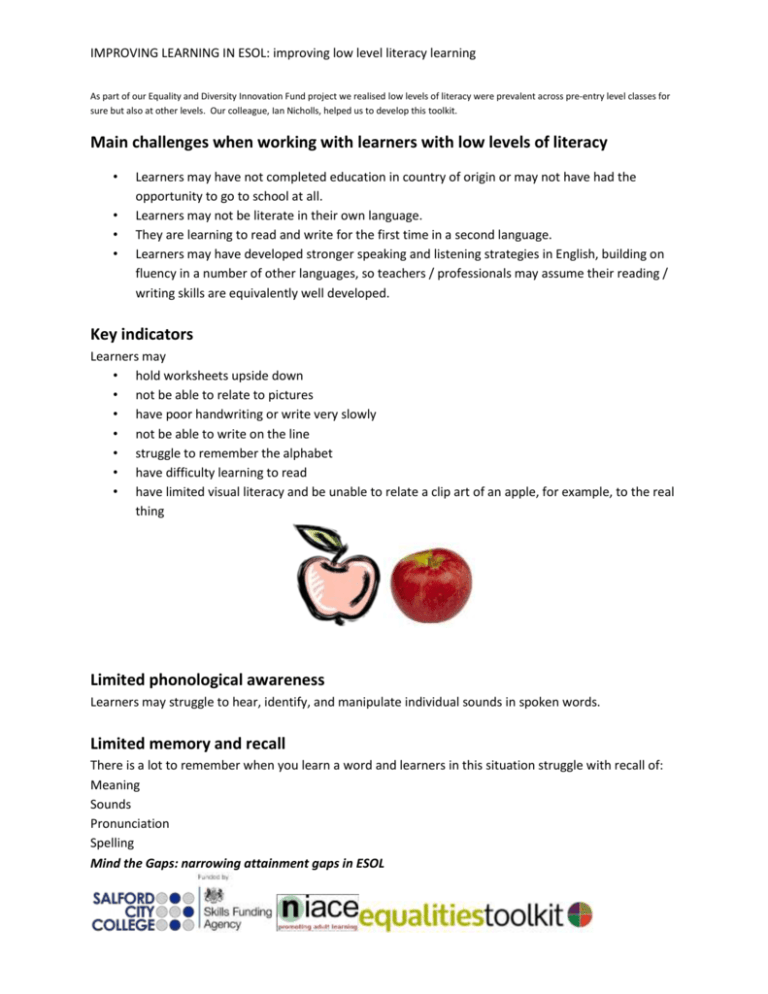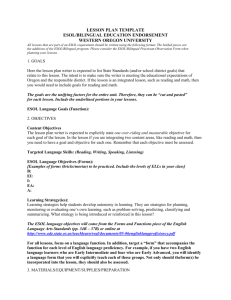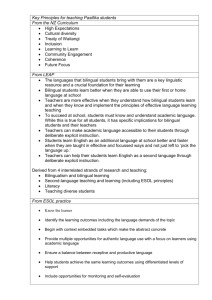low literacy levels - Equalities Toolkit
advertisement

IMPROVING LEARNING IN ESOL: improving low level literacy learning As part of our Equality and Diversity Innovation Fund project we realised low levels of literacy were prevalent across pre-entry level classes for sure but also at other levels. Our colleague, Ian Nicholls, helped us to develop this toolkit. Main challenges when working with learners with low levels of literacy • • • • Learners may have not completed education in country of origin or may not have had the opportunity to go to school at all. Learners may not be literate in their own language. They are learning to read and write for the first time in a second language. Learners may have developed stronger speaking and listening strategies in English, building on fluency in a number of other languages, so teachers / professionals may assume their reading / writing skills are equivalently well developed. Key indicators Learners may • hold worksheets upside down • not be able to relate to pictures • have poor handwriting or write very slowly • not be able to write on the line • struggle to remember the alphabet • have difficulty learning to read • have limited visual literacy and be unable to relate a clip art of an apple, for example, to the real thing Limited phonological awareness Learners may struggle to hear, identify, and manipulate individual sounds in spoken words. Limited memory and recall There is a lot to remember when you learn a word and learners in this situation struggle with recall of: Meaning Sounds Pronunciation Spelling Mind the Gaps: narrowing attainment gaps in ESOL IMPROVING LEARNING IN ESOL: improving low level literacy learning Letters Grammar Task Analysis of a matching activity 1. Orient the paper so words are right side up. 2. Identify each picture: a. Possess visual literacy skills to recognize clip art and identify the item represented. b. Form a mental model. Is it a familiar concept? 3. Remember the English name for the picture. 4. Correctly read the four words on the right. 5. Understand that the words and pictures are in different orders. 6. Understand the goal is to connect the picture and word. 7. Associate the picture with the correct word. 8. Use a pen or pencil to draw a line. 9. Draw a line connecting the picture with the correct word. 10. Understand that crossing lines are acceptable. 11. Recognize the one-to-one correspondence of the words to pictures. 12. Work through the task until all words and pictures are matched This is slightly adapted from the work of Jean Marrapodi and her 2013 paper What Doesn’t Work for the Lowest Level Literacy Learners and Why?. Mind the Gaps: narrowing attainment gaps in ESOL IMPROVING LEARNING IN ESOL: improving low level literacy learning Best advice Include both communicative and literacy goals in targets on learning plans. Alphabetic Anchors: an alphabet based on a low level ESOL lexicon to aid memorising initial phonemes. What easy-to-remember people or places could be used for each letter of the alphabet? S Salford M Manchester P Post office J Job (centre?) H house, hospital L– London T Television FFamily Word Wheels Include word families and rhyming to help learners with phonemic awareness Include high frequency words which are useful when beginning to learn Use British English and use familiar UK pictures (houses, food etc.) Use colour photographs whenever possible Use a language experience approach Work with learners to create a text, for example the following text and then work through the different stages: We have a walk near college. We see many things. Many cars, bus. We see Tesco, big shop. Across the street, there is a big car park. Very big. We see Post Office. On other side there is school. We walk back to college. Mind the Gaps: narrowing attainment gaps in ESOL IMPROVING LEARNING IN ESOL: improving low level literacy learning STEP 1: Noticing 1. Circle “we”. How many times do you see “we”? 2. Underline all the words that begin with “s.” 3. Circle There is and There are. 4. Look at shop, street, school. How are these words the same? How are they different? STEP 2: Create a gap fill STEP 3: Yes / No questions (eg Near my college, there is a park. STEP 4: Letter sort S C see, street, shop college A H across, are house, have STEP 5: Progressive reading 1. Teacher reads aloud as learners listen and follow along 2. Learners read silently 3. Choral reading 4. Paired reading 5. Individual silent reading STEP 6: First letter/sounds CHS __ollege __ave __ouse __chool __ee __treet STEP 7: Word Family Shop Shoe Shampoo She Shell Mind the Gaps: narrowing attainment gaps in ESOL YES NO) IMPROVING LEARNING IN ESOL: improving low level literacy learning Shave Shirt STEP 8: Same or different house house see street walk talk back bank college college shop school STEP 9: Personalise Step 10: Grammar Mind the Gaps: narrowing attainment gaps in ESOL








